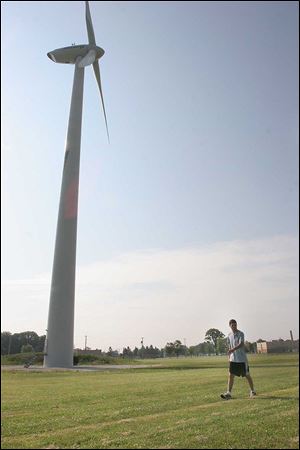
Carcass hunt drives UT senior’s internship
Deaths of birds, bats focus at wind turbine
7/5/2013
Schide
THE BLADE/LISA DUTTON
Buy This Image

Schide
Bryce Schide has a unique summer internship.

UT student Bryce Schide surveys the land around the Clay High wind turbine, seeking birds and bats that may have been injured or killed.
The University of Toledo senior, who is studying environmental science, surveys land near Clay High School’s wind turbine three or four mornings a week, checking to see whether migratory birds or bats are being killed by the whirring blades.
Mr. Schide surveys a grid that’s twice the turbine blades’ span. Within that grid, he walks up and down, checking for bat and bird carcasses — primarily at sunrise, which makes for more accurate mapping, because doing so reduces the risk that scavenging animals will find them before he does.
But so far, he hasn’t found any evidence.
“I haven’t found any birds. I definitely think that says a lot,” he said, though he noted that he can’t make conclusions because data have not been collected long enough.
Caine Kolinski, a Clay science teacher, and Dennis Slotnick, a biology and environmental teacher there, said they hope student researchers like Mr. Schide can collect data for a minimum of three years.
The 900-kilowatt turbine generates as much as energy as the school uses.
Mr. Schide started the project because he was seeking information on the subject, but couldn’t find any in traditional sources.
“Since I can’t find anything, I might as well make it my internship,” he said, talking about how the idea originated.
Mr. Kolinski said several groups of Clay students have surveyed the same space under the turbine during the spring semester. He said the work will help collect “real data to inform the public and establish policy.”
Mr. Slotnick, who is also the wind research facility coordinator at the school, said the research implications go beyond just the local data.
“If Bryce can prove that [birds aren’t killed by the turbine], this totally reopens the debate, even in Lake Erie. It opens up the possibility that other parts of Lake Erie could be opened up to wind energy,” he said.
The large turbine at Clay only moves at a pace of about one revolution every three seconds, he said, adding that the school has not received complaints about noise.
Mr. Slotnick said many claims that birds get killed by turbines could be formulated based on equipment from older years.
Stating that wind turbines have evolved since the 1970s and are less rigid, Mr. Slotnick said the Clay turbine’s blades are torqued, which helps to buffer some of the noise they might otherwise make.
“As the wind gets stronger, it just cranks out more power, not more speed,” he said.
“It never whips like an egg beater.”
There are many other factors that go into creating conditions that potentially create higher numbers of bat and bird kills from turbines.
Low clouds or fog, storms, or other bad weather could cause a higher kill rate, Mr. Slotnick said, in part because dangerous weather causes migratory birds — including warblers — to change their routes.
The only casualty the research has identified so far is a single red bat, found beneath the turbine in November.
“This is turning out to be an extremely good location,” Mr. Slotnick said. “As the field expands, it looks like more of a threat to bat populations than birds.”
Contact Kelly McLendon at: kmclendon@theblade.com or 419-724-6522, or on Twitter @KMcBlade.